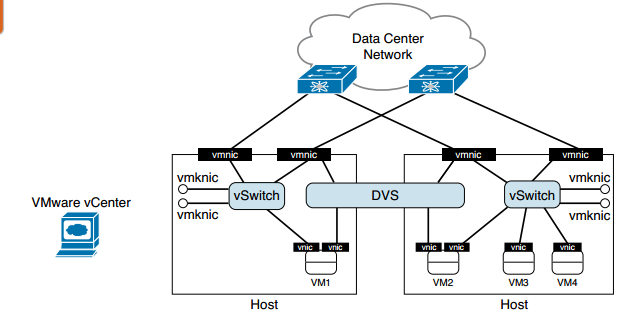210-451 CCNA Cloud CLDFND FAQ – Infrastructure Virtualization
Q1. Which of the following is not applicable to virtual switching in general?
a. Responsible for virtual machine Layer 2 connectivity
b. Can be configured per host, without the use of a VM manager
c. Does not allow live migration of VMs
d. Supports LACP
e. Can belong to more than one host
Q2. Which of the following are differences between the VMware vNetwork Standard Switch and the VMware vNetwork Distributed Switch? (Choose four.)
a. VMware vCenter requirement
b. Uplink Port Groups
c. Allows VMotion
d. Resides in more than one host
e. Permits Port Groups with distinct load balancing methods
f. Supports LACP
Answer: a, b, d, and f
Q3. Which of the following virtual devices can be considered distributed virtual switches? (Choose three.)
a. VMware vSS
b. Open vSwitch
c. Microsoft Virtual Network Switch
d. Linux bridge
e. VMware vDS
f. Cisco Nexus 1000V
Q4. Which of the following are correct about Cisco Nexus 1000V Switch for VMware vSphere? (Choose four.)
a. The communication between the VSM and VEM requires Layer 3 connectivity.
b. The communication between the VSM and VEM requires Layer 2 connectivity.
c. The VEM runs inside the VMware vSphere kernel.
d. The VEM does not run inside the VMware vSphere kernel.
e. Cisco Nexus 1000V can coexist with other virtual switches in the same host.
f. Cisco Nexus 1000V cannot coexist with other virtual switches in the same host.
g. The communication between active and standby VSMs requires Layer 3 connectivity.
h. The communication between active and standby VSMs requires Layer 2 connectivity.
Q5. Which of the following are correct associations of Cisco Nexus 1000V interfaces and VMware vSphere interfaces? (Choose two.)
a. Ethernet and vnic
b. vEthernet and vmk
c. vEthernet and vmnic
d. Ethernet and vmnic
e. Ethernet and vmk
Q6. Which of the following is not a Cisco Nexus 1000V feature?
a. vTracker
b. PortChannel
c. DHCP server
d. Private VLAN
e. TrustSec
Q7. Which hypervisors support Cisco Nexus 1000V? (Choose three.)
a. Microsoft Hyper-V for Windows 2008
b. Microsoft Hyper-V for Windows 2012
c. VMware vSphere
d. Xen
e. KVM
Q8. Which protocols are used in the VXLAN encapsulation header? (Choose two.)
a. TCP
b. GRE
c. UDP
d. IP
Q9. Which of the following are advantages of VXLANs over VLANs? (Choose three.)
a. Avoids MAC address table overflow in physical switches
b. Offers easier provisioning of broadcast domains for virtual machines
c. Provides more segments
d. Use IP multicast
e. Deploys flood-based learning
Q10. Which of the following represent improvements of Cisco Nexus 1000V Enhanced VXLAN over standard VXLAN deployments? (Choose two.)
a. Uses less MAC addresses
b. Does not require IP multicast
c. Eliminates broadcast and unknown unicast frames
d. Eliminates flooding
Answer: b and d
More Resources
